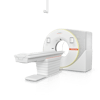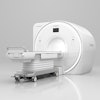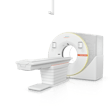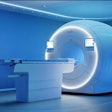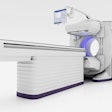Fueled by promising clinical results, the PET market is on fire this year, and many companies are pouring R&D funds into the long-neglected technology in hopes of riding the updraft. Visitors to nuclear medicine vendors' booths at the RSNA show will see new systems that offer PET technology at new price points, and new scanners that combine PET with anatomical imaging modalities.
The nuclear medicine market got hit with a dose of consolidation just before the conference, when Philips Medical Systems announced an agreement to purchase ADAC Laboratories. The deal marks the return of Philips to a modality it abandoned almost 10 years ago, and will put the Dutch vendor on par with other companies that offer nuclear medicine systems.
ADAC Laboratories
The biggest news in the ADAC booth is undoubtedly the company's decision to be acquired by Philips, which will pay $426 million in cash for the Milpitas, CA, company.
ADAC believes that the company's customers will benefit from the increased resources available from Philips for product development. ADAC will also get access to Philips' distribution network, which is strong in many international areas where ADAC is weak.
On the product side, ADAC will introduce a work-in-progress PET scanner at the conference based on a new detector material, gadolinium-oxyorthosilicate (GSO). ADAC believes the product will lead to significant improvements in image quality, and a substantial decrease in imaging time.
On the gamma camera side, ADAC will introduce the production version of its Skylight ceiling-mounted gamma camera. The system was first displayed at last year's RSNA meeting as a work in progress, and ADAC will start commercial shipments shortly after this year's show. The company's RSNA display will demonstrate Skylight's versatility, and will enable attendees to evaluate the room layout, imaging capabilities, patient table, and collimator exchanger.
Gamma Medica Instruments
This Northridge, CA, developer of small field-of-view gamma cameras plans to introduce a new dedicated SPECT camera for small-animal studies. The system is capable of detecting tumors as small as 1 mm, according to the company.
GE plans to debut a new version of its flagship Advance PET camera to take advantage of the hot PET market. Advance NXi is optimized for routine clinical 2-D and 3-D studies, but is also appropriate for research use, according to the Waukesha, WI, company.
GE executives say that Advance NXi features a high-speed detection system that results in good image quality without sacrificing the count-rate performance and sensitivity necessary for whole-body acquisitions. The camera also does not use data reduction techniques such as "mashing," which GE says degrade image resolution.
In the SPECT realm, GE will highlight the Hawkeye upgrade for its Millennium VG gamma camera. Hawkeye consists of an x-ray source and a CT detector mounted on Millennium VG's slip-ring rotor. The upgrade enables Hawkeye users to collect anatomical data during a nuclear medicine scan, with the resulting images providing both functional and anatomic information. GE began shipping Hawkeye this year. Another option available on Millennium VG is CoDe, which enables high-energy coincidence detection imaging.
On the workstation side, Entegra is a new image processing computer the company is rolling out for nuclear medicine studies. Entegra employs Intel Pentium processors and the Windows NT operating system to deliver high performance at a reasonable price, according to the company.
Next page:
Positron through Toshiba
